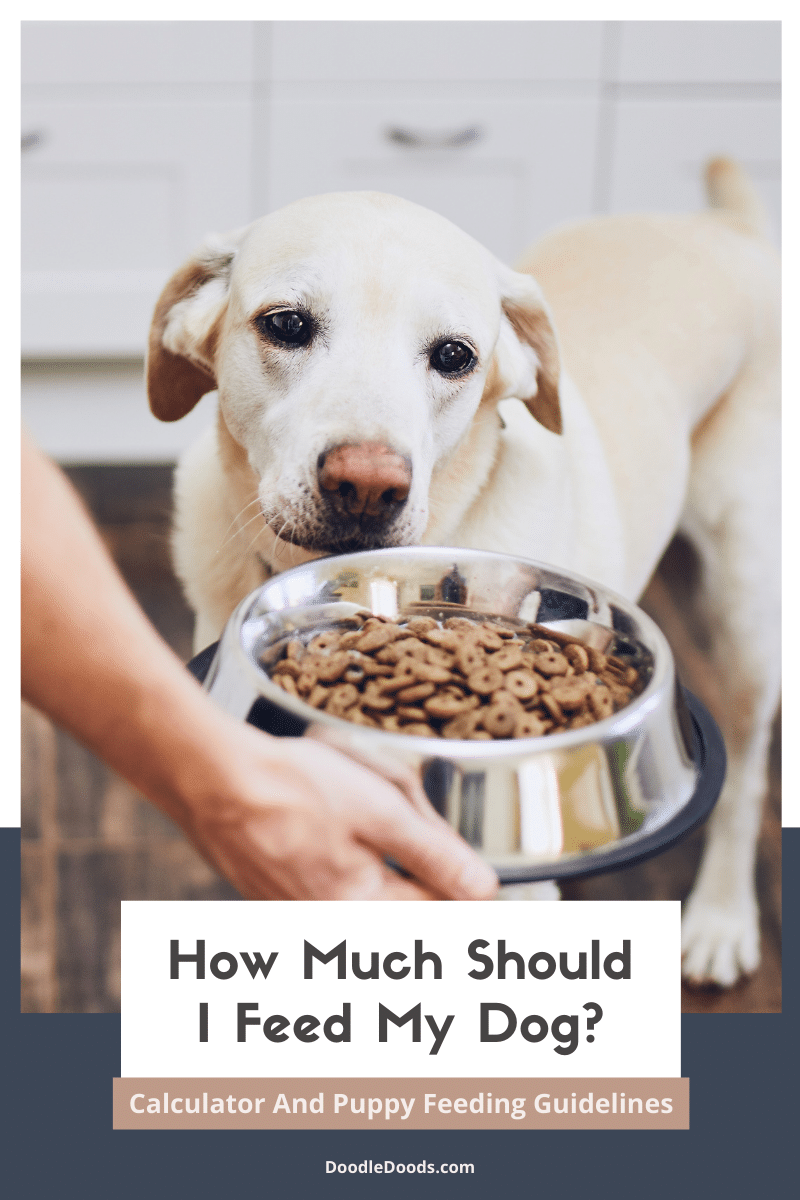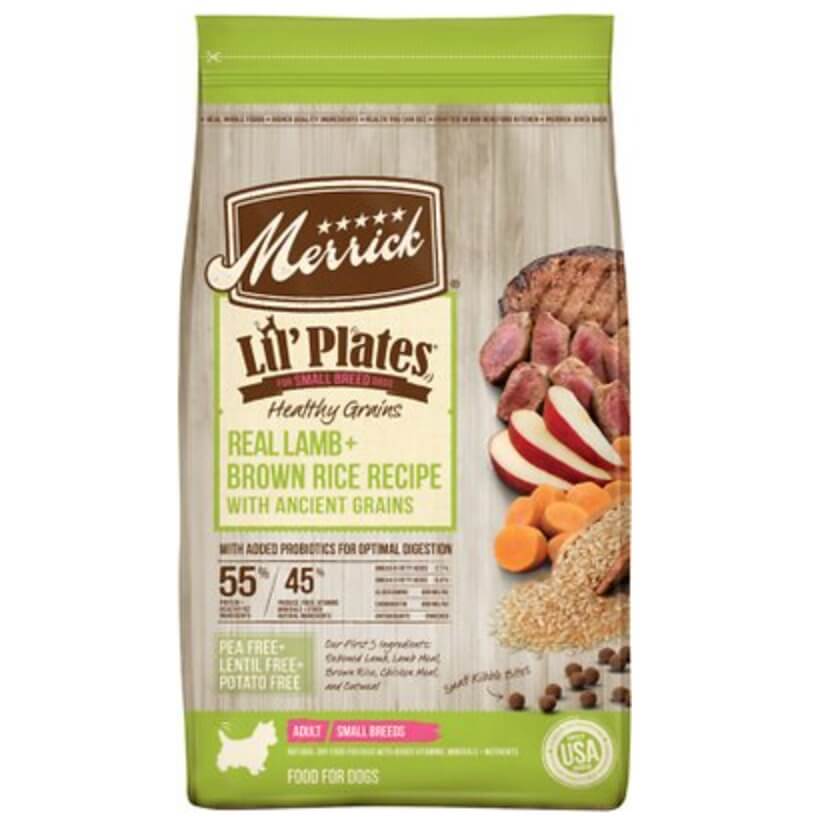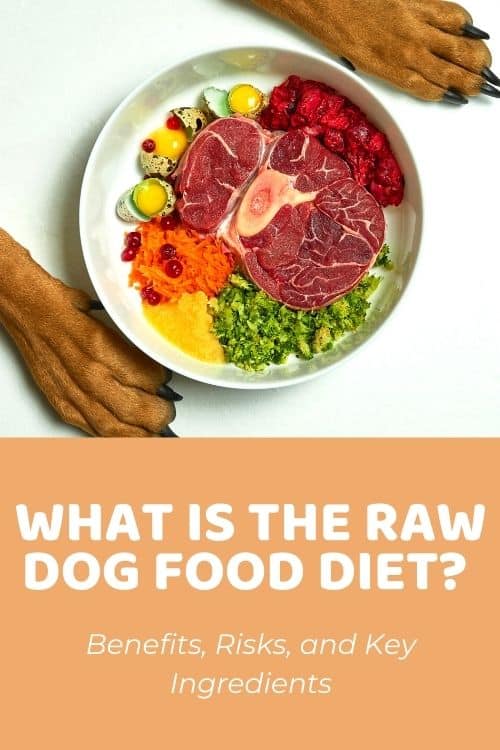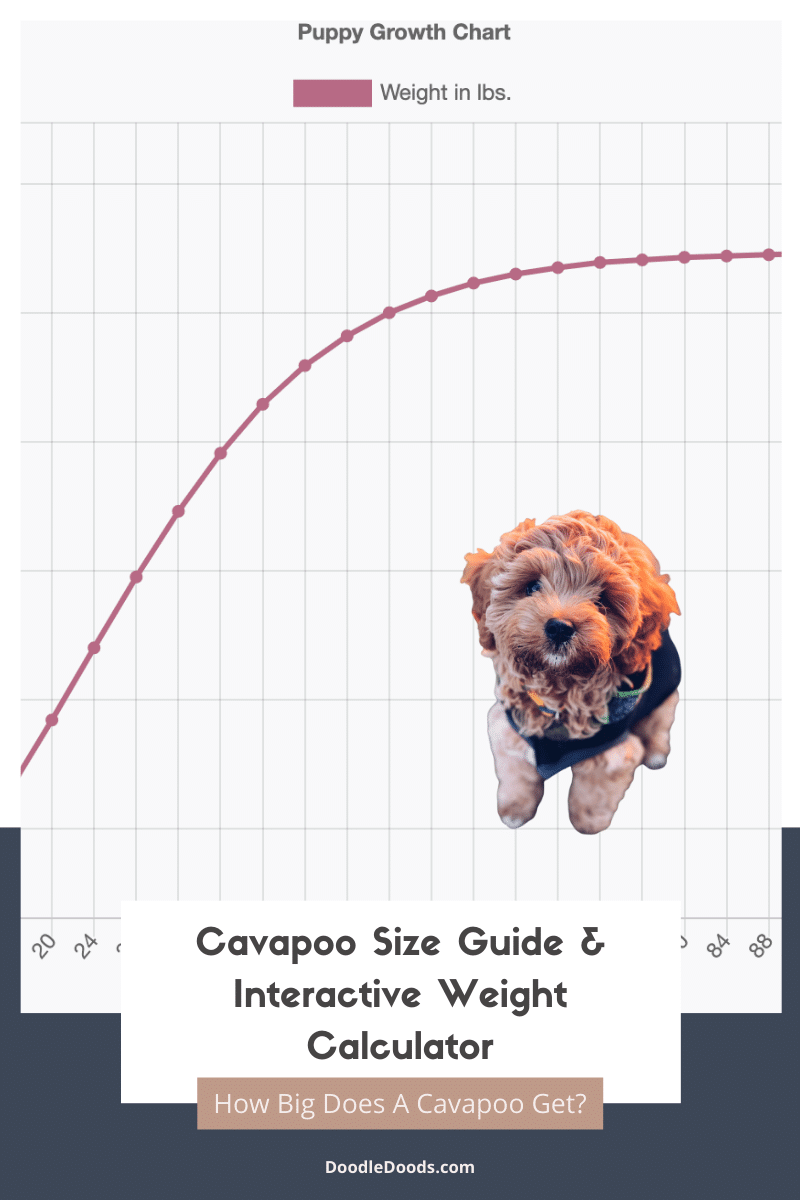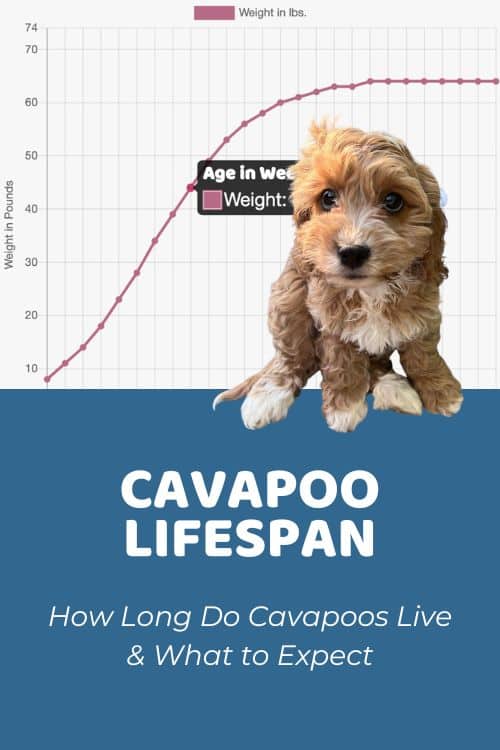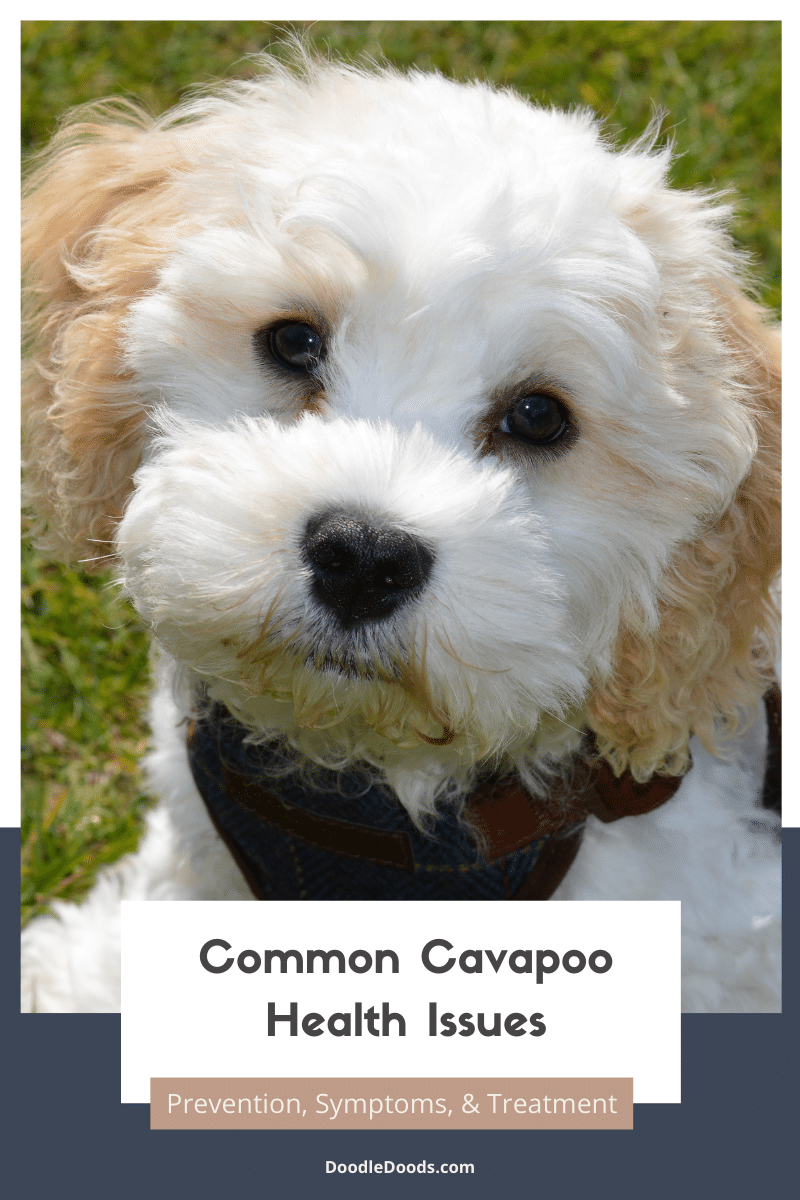In any supermarket, you are likely to find stacks of dog food. Everything from canned wet food to enormous bags of kibble that you can’t even pick up, let alone carry home! Luckily these days, a couple of clicks of your mouse can get your pup’s favorite chow delivered directly to your door – no muss, no fuss.
However, you still have the issue of pages and pages of options that all look good. How will you ever decide? Food is such a fundamental part of maintaining your dog’s health and wellbeing, you need to get it right.
No fear! We’ve done all the grueling research for you, picking out the very best of the best dog food for Cavapoos based on expert advice and literally hundreds of reviews. You can feel confident that any of the following foods contain everything your pup needs to keep up their happy, doggy ways.
Our Top 6 Vet-Approved Foods for Cavapoos
Here are our best foods for Cavapoos with handy links to where you can find them. If you want to learn a little more about them, keep scrolling.
-
Pick #1:
Halo Holistic Chicken & Chicken Liver Small Breed Dry Dog Food. The perfect size for your little Cavapoo, Halo’s kibble with its cage-free chicken and non-GMO fruits and vegetables is delicious, nutritious, and our top choice.
-
Pick #2:
Hill’s Science Diet Adult Small & Mini Perfect Weight Dry Dog Food. For pups who have piled on the pounds, Hill’s Science Diet food is clinically proven to support safe and effective weight loss with visible results in just 10 weeks.
-
Pick #3:
Blue Buffalo Life Protection Formula Small Breed Senior Chicken & Brown Rice Recipe Dry Dog Food. Designed specifically for dogs who are getting on a bit, Blue Buffalo’s Senior Recipe is packed full of health-promoting ingredients carefully selected by experts.
-
Pick #4:
Purina Pro Plan Small Breed Adult Sensitive Skin & Stomach Formula Dry Dog Food. Optimized for digestive health and skin and coat nourishment, Purina’s Sensitive formula, which has no artificial ingredients, is great for pets with food sensitivities.
-
Pick #5:
Merrick Lil’ Plates Healthy Grains Real Lamb + Brown Rice Recipe Small Breed Adult Dry Dog Food. With a taste to tempt even the fussiest pooch, Merrick’s Lil’ Plates Dry Dog Food with real lamb and ancient grains perfectly suits the dietary needs of smaller breeds.
-
Pick #6:
Diamond Naturals Small Breed Adult Chicken & Rice Formula Dry Dog Food. Rich in antioxidants, vitamins, and minerals and enriched with beneficial probiotics, Diamond Natural’s kibble can significantly boost your Cava’s health and wellbeing.
-
Pick #7:
Wellness Small Breed Complete Health Puppy Turkey, Oatmeal & Salmon Meal Recipe Dry Dog Food. Containing essential nutrients that support growth, brain development, the immune system, and more, Wellness’ Puppy recipe gives fur babies the best start in life.
Cavapoo Nutritional Needs: A Quick Overview
While, on the whole, dog nutrition is pretty generalizable, there are some differences in the feeding needs of smaller and larger dogs – most notably, the size of the kibble they should be given and how often they should be fed.
Small dogs require a little-and-often diet to help keep them ticking over throughout the day. Experts recommend a minimum of four meals dished up at regular intervals. One of the key reasons for this, as outlined by PetMD, is that smaller breeds have extremely high metabolic rates. This means that they also need more calorie-dense food than larger ones.
You also need to consider your pup’s specific life stage as this will also impact the number of calories and the different kinds of nutrients they require. For instance, younger dogs, being more energetic, will have higher calorie needs than older dogs that have significantly slowed down. Puppies will benefit from extra calcium as their bones and teeth develop, whereas omega fatty acids can keep oldies more mobile.
Common Cavapoo Health Issues and How Food Can Help
Mixed breeds are generally considered healthier than their pedigree counterparts. Yet, they are still prone to some common canine conditions.
The good news, however, is that many foods these days contain vital supplements to keep your pup happy and healthy such as:
Allergies
Inherited from the Poodle part of the package, allergies, sensitivities, and intolerances are common to Doodles—these manifest as digestive problems, skin itchiness, and more. You can find some great kibble, free from fillers, additives, and other known canine allergens and that contains omega fatty acids to soothe and hydrates irritated skin. Check out our ‘sensitive souls’ pick below.
Oxidative Stress
Smaller breeds with their lovely, long lifespans need to be protected from free radical damage. This can impact their nervous and immune systems and speed up the progression of conditions like heart disease and cancer. PetMD highlights the importance of antioxidants such as vitamin E, vitamin C (citric acid), vitamin A, carotenoids, and selenium to fight against this.
While feeding your pup the right kind of food is incredibly important, so too is the amount you give them and how often. Pay special attention to how many calories your pup needs per day and recommended feeding patterns to avoid the following:
Hypoglycemia
Low blood sugar is a potentially serious issue specific to small breeds. This condition can be a particular problem for puppies as they have not fully developed the ability to regulate their blood glucose levels. Symptoms of hypoglycemia include extreme lethargy and trembling, among other things. The little-and-often diet is best for avoiding this.
Obesity
Obesity, which is becoming an epidemic in this country’s canines, can mean stress on your pup’s joints and even their heart and other organs. A higher-quality food with fewer carbs can help, but you also need to pay close attention to how many calories your dog needs each day – it’s likely less than you think!
Best Foods for Cavapoos: Buyer’s Guide
One of the very first choices you face when picking out the perfect food for your pooch is wet vs. dry. Both have advantages and disadvantages:
Wet Food
The best option for picky eaters that you simply can’t coax towards kibble (although sometimes a mix of the two will do it), wet food comes in single-serve cans or pouches that you simply open up and dump into your pet’s bowl.
Some owners prefer this food because it contains more water, so you can be sure that your pup is keeping hydrated (especially in warmer climates). The downside is that it is more expensive and doesn’t always have as good a nutritional profile as kibble.
Dry Food
Typically, this comes in pellets created by breaking all the ingredients down and melding them together. Kibble is available in varying-sized bags from small to very, very big!
You can’t go wrong with a decent kibble. It is relatively inexpensive and has a long shelf life, allowing you to take advantage of bulk buying discounts. Another great thing about it is that crunching down on the biscuits helps keep your pet’s teeth clean. The downside is it might not be as appealing to your fussy pup.
Whichever type of food you opt for, you want to ensure that it has a balanced blend of nutrients to suit your Cava’s needs. When it comes to the three main elements of food – protein, fats, and carbohydrates – your dog requires specific amounts of:
Protein
While there is some debate among experts about whether dogs are carnivores or omnivores, one thing’s for sure: protein is a fundamental part of their diet. That’s why the best brands on the market feature meat as their top ingredient. This should make up no less than 18% of your pup’s feed as per guidelines set out by the Association of American Feed Control Officials (AAFCO).
Fats
While fats are the enemy in a human diet because of rising cholesterol levels, this is not an issue for canines. In fact, dogs are more likely to have problems when their fat levels are too low. These include a dull coat, impaired immune function, diabetes, and heart disease, among other things. Animal fats are best, but some plant-based ones like sunflower and soybean oil contain helpful nutrients. Your dog food of choice should be around 10 to 15% fat-based.
Carbohydrates
Carbohydrates are a great source of energy for dogs, as well as dietary fiber. The issue here is that if your pal receives too many carbs at each sitting, they could quickly put on weight. Manufacturers often include high-carb ingredients in their foods because they are cheap – so keep an eye out for this. There are no specific amounts, but generally the fewer the better.
Best Foods for Cavapoos: Reviews
Best for Regular Use
Clean, green and focused on providing dogs with the very best nutrition with super healthy, honest ingredients, Halo definitely wins the best in show award. Their ‘Holistic, Whole and Humane’ policy means that their recipes contain only whole meats rather than meat meal – which isn’t necessarily bad as long as you know exactly what you’re getting (but you rarely do). Whole meats are also easier for your pet to digest so they really are getting all the good stuff.
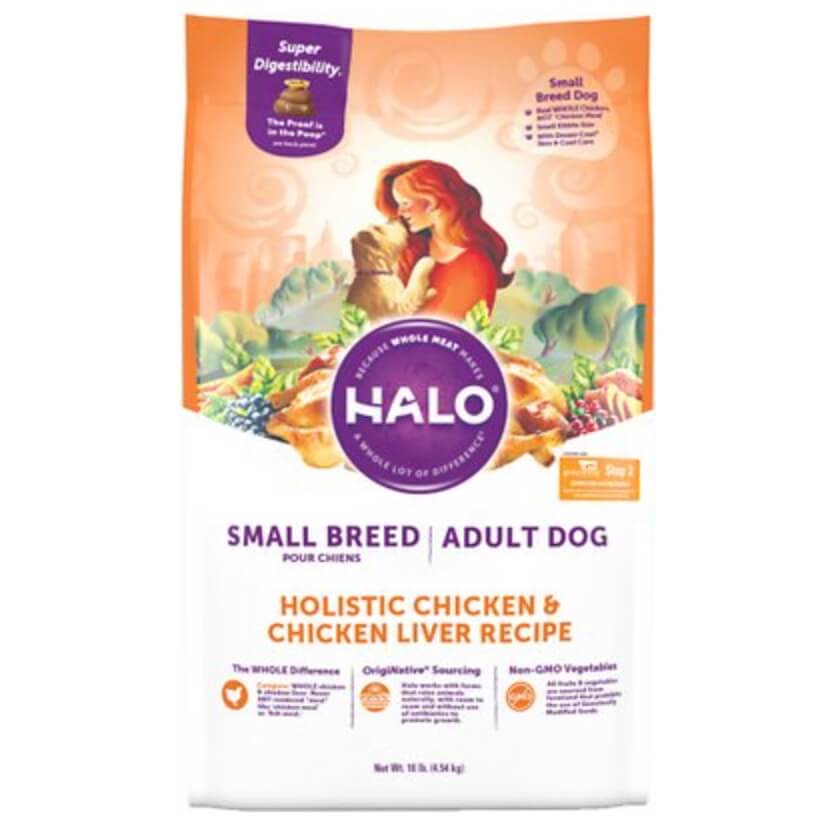
High on the list of reasons people pick this food is that they can understand all the ingredients. This makes them feel more confident about giving this food to their pup. Reviewers also comment that the kibble doesn’t smell, is a good size for small dogs, and has a nice crunch. Even picky, non-kibble-loving eaters seem impressed.
Pros
The nutritional benefits of this food are clear and easy to see, the ingredients are simple, and most dogs enjoy it.
Cons
Negative reviews are about some dogs not liking the food. Mixing in wet food, low-sodium stock, or specially designed kibble toppers could convince them to give it a go.
Best for Weight Loss
Based, as the name suggests, on scientific research into nutrition, Hill’s Science Diet food has all the taste and benefits of other foods on this list but much fewer calories. Chicken is an excellent source of lean protein and generally a popular choice in the world of dogs. The added vitamins, minerals, antioxidants, and probiotics in the food ensure that it exceeds the industry standards for small breed nutrition.
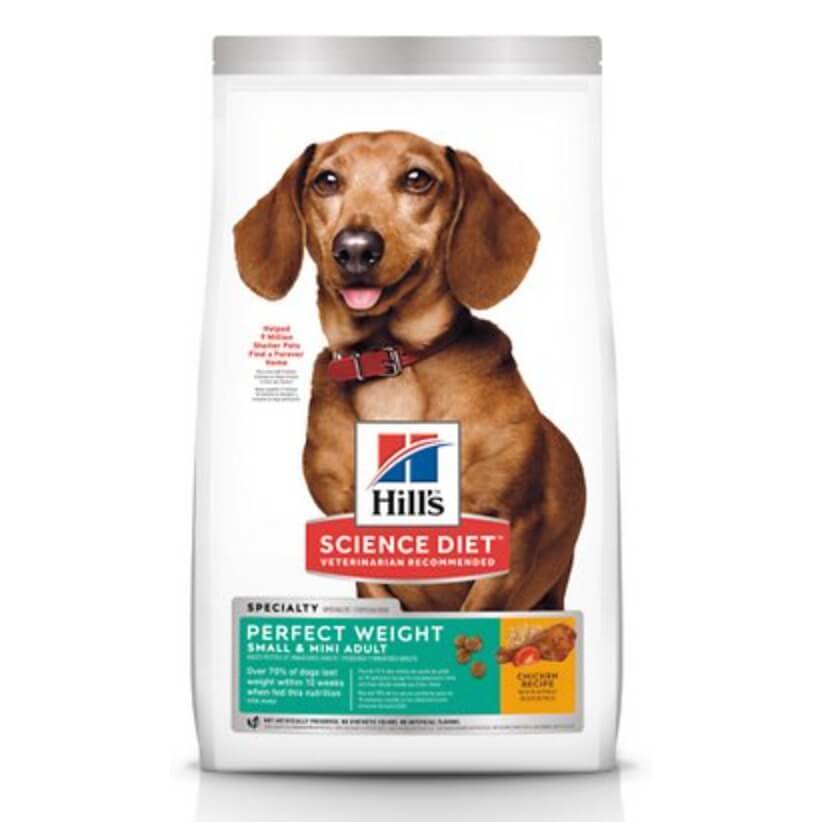
With the majority of reviewers stating they would recommend this food to a friend, you can be sure that you’re getting a good deal with this brand. Moreover, it seems to do just what it promises in helping pups – even seniors-lose weight in a healthy way. Many owners were turned on to this food by their vet. You can’t get higher praise than that when it comes to pet food.
Pros
A trusted brand and an excellent low-cal, low-fat option recommended by experts for ‘chunky’ dogs.
Cons
A couple of pet parents mention sensitivities… this might be due to issues with chicken which can develop even later in life.
Best for Older Dogs
Blue Buffalo’s Senior range has all the goodness of regular adult formulas but with added nutrients, such as immune-boosting antioxidants (explained above). Plus, while the calories per cup for this tasty kibble are still high enough to sustain your smaller pup, they are slightly lower than other foods on this list which helps prevent weight gain in less active dogs.
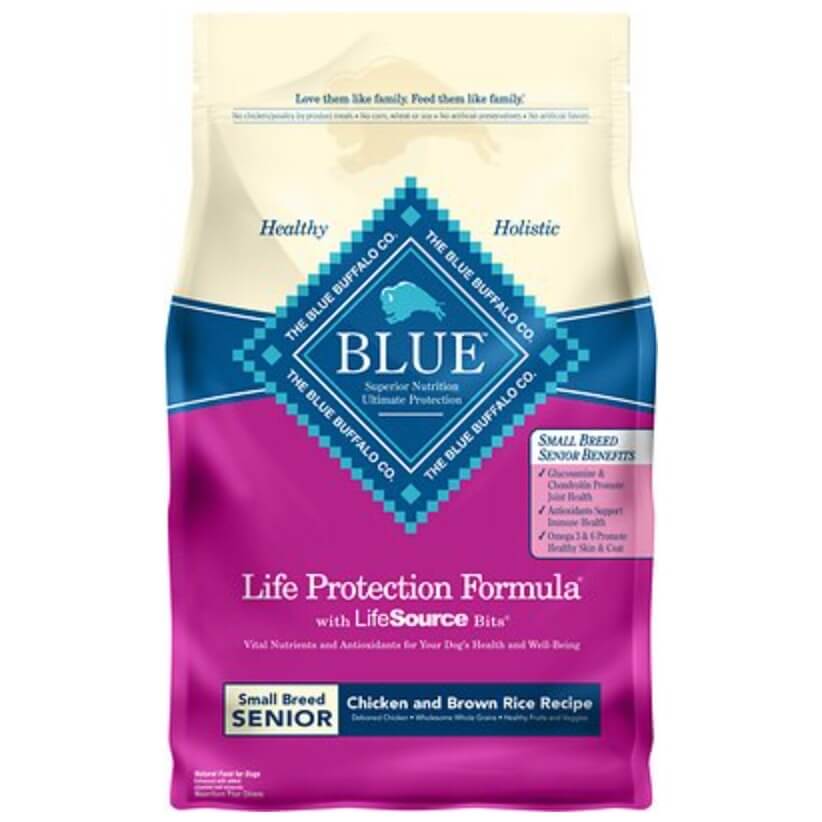
Reviews for this food are excellent, with pet parents commenting that the pellets are small and soft enough for elderly dogs to chew. They are also impressed with the healthy ingredients that are also tasty enough to tempt their fussy pups. Many also mention that they have seen a marked increase in the energy levels of their pet since switching over to this brand.
Pros
Life-stage foods are the best way to ensure your dog is getting just what they need. This one contains an array of excellent nutrients for elderly small breeds.
Cons
Some dogs can be a little fussy about eating the important LifeSource Bits. Again, try mixing in some treat food to encourage them to try them.
Best for Sensitive Souls
Food sensitivities can be a nightmare for owners, especially when linked to common pet food ingredients like chicken. Luckily there are plenty of other available options. Purina’s Salmon and Rice formula is one of the best as far as we are concerned. It provides balanced nutrition without corn, wheat or soy, or artificial colors or flavors. Instead, it is rich in lean protein, probiotics, prebiotic fiber for digestive health, and essential vitamins and minerals.
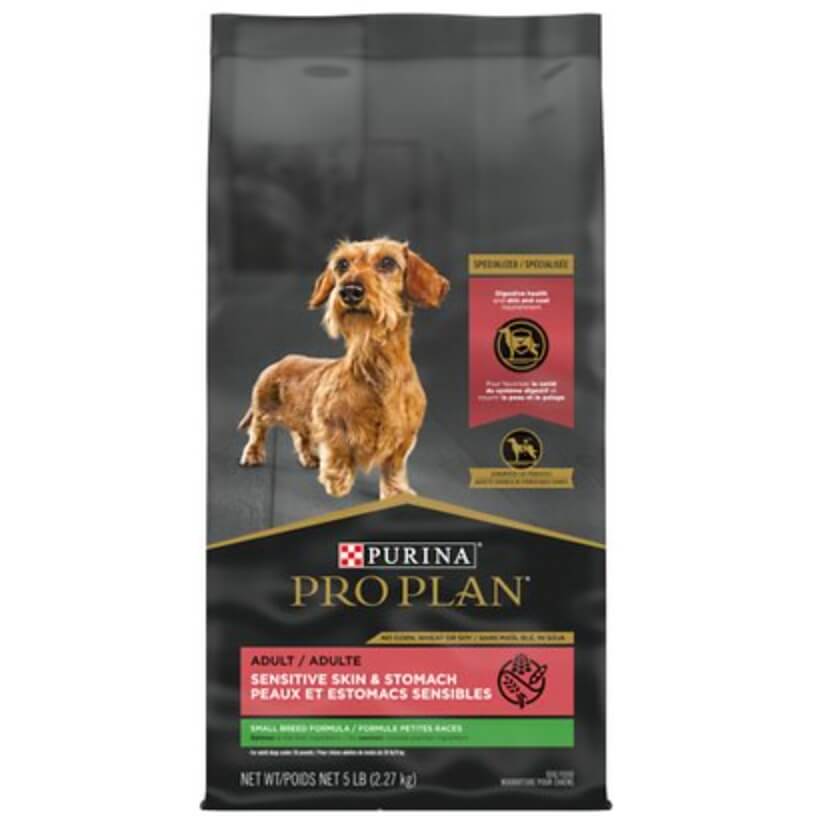
Many people have switched to this formula from either a grain-free or chicken one, based on expert recommendations. They notice better gut health, improvements in coat and skin condition, and a reduction in licking and scratching. Better yet, most dogs seem to love the taste of this great kibble.
Pros
This food is a godsend for those who have been tearing their hair out trying to find one that their pet will eat and that will help relieve their allergy symptoms.
Cons
Take care, this food is higher in calories than other brands. You may have to reduce the amount you are giving your pet and keep a close eye out for any signs of weight gain.
Best for Picky Eaters
30 years of working towards the very best pet food, Merrick has developed an excellent line of dog kibble. Featuring real meat as the top ingredient, whole, and ancient grains that aid digestibility, probiotics and prebiotic fiber for gut health, and glucosamine and chondroitin to help keep joints limber, these quality foods come highly recommended. This one is particularly popular with pups who are bored with more common dog food flavors.
“Perfect for smaller dogs,” “great brand,” and “my dogs couldn’t get enough of it” are just some of the comments left by satisfied customers. In fact, we selected this as our ‘best for picky eaters’ because of the sheer number of reviewers who talk about not being able to get their dog to eat kibble before purchasing this brand.
Pros
The high-quality, tasty, tempting ingredients make this food excellent not just for fussy pups but for picky parents too.
Cons
The food is on the higher end of the dry dog food price range. This is likely down to the price of lamb vs. chicken.
Best for Recovering Pups
With its exceptional ingredients, probiotic technology, and added superfoods, Diamond Natural’s kibble has a truly excellent nutritional profile. It’s great for pups who need a health boost. Kale, blueberries, chia seeds, and pumpkin (to name but a few) provide a powerful antioxidant and vitamin kick, while the omega fatty acids help support skin and coat health.

Impressed with the quality of the ingredients and the extremely reasonable price, reviewers also rave about how much their dogs love this food, how easy it is for them to chew, and how noticeable the health benefits are. It’s all ‘love,’ ‘love,’ ‘love’, right the way down the line, with one customer even giving the product ‘a big paws up’.
Pros
Seriously, this food has so many great ingredients it’s almost good enough to convince us to give it a go! Almost…
Cons
This exceptional dry food doesn’t seem to have any downsides at all.
Best for Puppies
At the other end of the scale from our senior pick, Wellness’ Complete Puppy Health food is designed to support growing dogs. The high-quality protein contains amino acids which are the essential building blocks for life. Omega fatty acids support brain and healthy joint development. Calcium and phosphorus make bones and teeth super strong. The extra fat content helps keep their energy levels up.
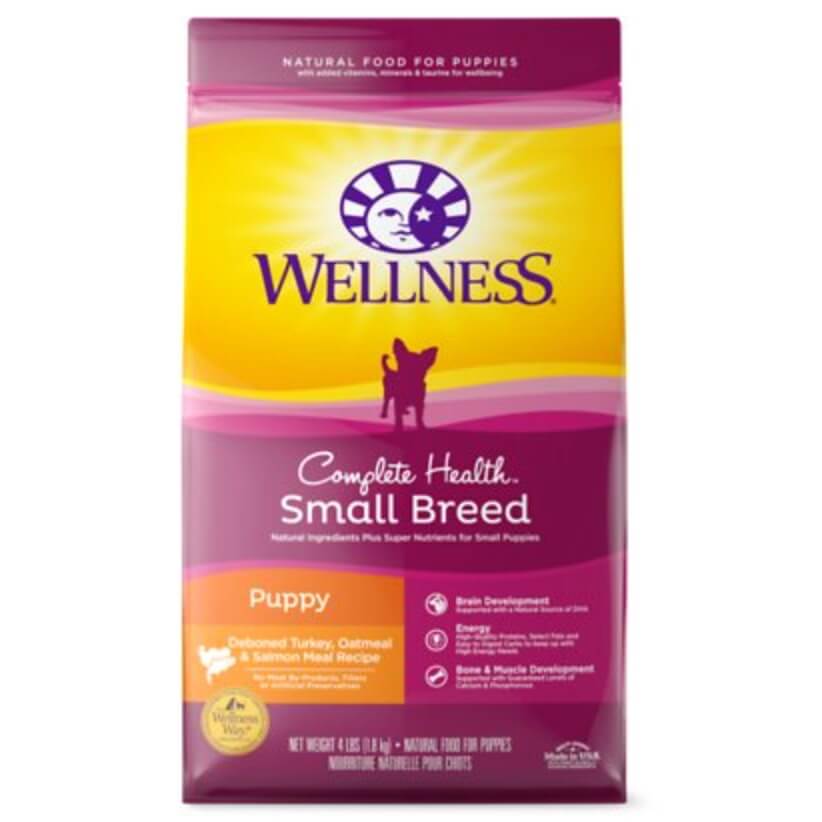
Reviews are generally positive on this one. Owners recognize that it is a terrific puppy food packed full of everything they need. The kibble is small and easy to chew, the food is great for digestion, and it seems to help with coat health too. Most puppies also seem to like the kibble right off the bat – always a plus!
Pros
Another perfectly balanced food that’s great for little ‘uns, with the higher number of calories that growing dogs need.
Cons
This food doesn’t seem to be quite as popular as the above brands among the canine population. This could be because often puppies are switching over to kibble from wet food, which, let’s face it, is never easy.
The Homemade Food Option
An alternative to both wet and dry food and a great way to ensure you know exactly what your pet is getting is to put together their food yourself.
A word of caution, if you do opt for this approach, you need to ensure a careful balance of all the right nutrients. This takes a fair bit of research.
Experts over at the American Kennel Club have put together a handy guide that can help you to get started.
Ingredients to Avoid in Cavapoo Food
While food sensitivities can be as specific to dogs as they are to people, there are a few ingredients that you should always avoid when picking out your Cavapoo’s food.
Chemicals and Preservatives: Butylated Hydroxyanisole (BHA) and Butylated Hydroxytoluene (BHT) are sometimes added to oils (fats) as preservatives. However, the safety of both these two chemicals has been questioned by experts.
Likewise, Ethoxyquin is another common preservative that has been linked to kidney and liver damage. Propylene Glycol (PG), a moistening agent, is also considered toxic.
Food Dyes: Many dyes such as Blue 2, Red 40, and Yellow 5 and 6 are responsible for particular sensitivities and reactions. As coloring is only used to appeal to owners by imitating the colors of fruits and vegetables and does absolutely nothing for dogs, it’s best avoided.
There is also still a lot of confusion on the use of grains in dog food. For more on this, take a look at our dedicated article: Is Grain-Free Good for Dogs? The Long Debate
Cavapoo Feeding Guide
PetMD recommends basing feeding amounts on the weight, life stage, and activity levels of your dog. Use a calculator such as this one to determine specifics and pay close attention to manufacturer guidelines which will take the calorie and fat content of the food into account.
Cavapoo Nutrition: Frequently Asked Questions
What human food can my Cavapoo eat?
While mostly you want to avoid feeding your Cavapoo from your own plate to discourage begging behaviors, some human foods can be used sparingly as treats if need be. Options include apples, peanut butter, and cooked meats.
For details on which foods you definitely shouldn’t feed your dog, check out What Can Dogs Not Eat? An Overview Of Harmful Foods For Doodle.
Are Cavapoos fussy eaters?
Unfortunately, Cavapoos are known for being quite picky eaters. They have sensitive stomachs and very discerning taste. This can make it a challenge for you to find the perfect food for your pet. Adding a little something of what they like to a new kibble can encourage them to at least try it. Watch out, though, for digestive issues and skin issues which can signal an intolerance.
Do Cavapoos eat a lot?
The amount that your pup should eat is dependent on their age, weight, life stage, and activity levels. Younger, bouncier Cavas will naturally crave more calories than older, more sedentary ones. Just make sure you are closely following feeding recommendations to ensure you are not giving them too much – even when confronted with those sad, puppy-dog eyes.
Beautiful, teddy-bear-like Cavapoos make excellent pets. They are happy, loyal, and full of love for their adopted families. Ensure you are taking the best care of your new fur baby by feeding them a balanced diet that contains everything they need for the best possible life. Here are some recommendations for tried-and-tested brands. Let us know what you think below.
Learn How to Care for Your Doodle Puppy!
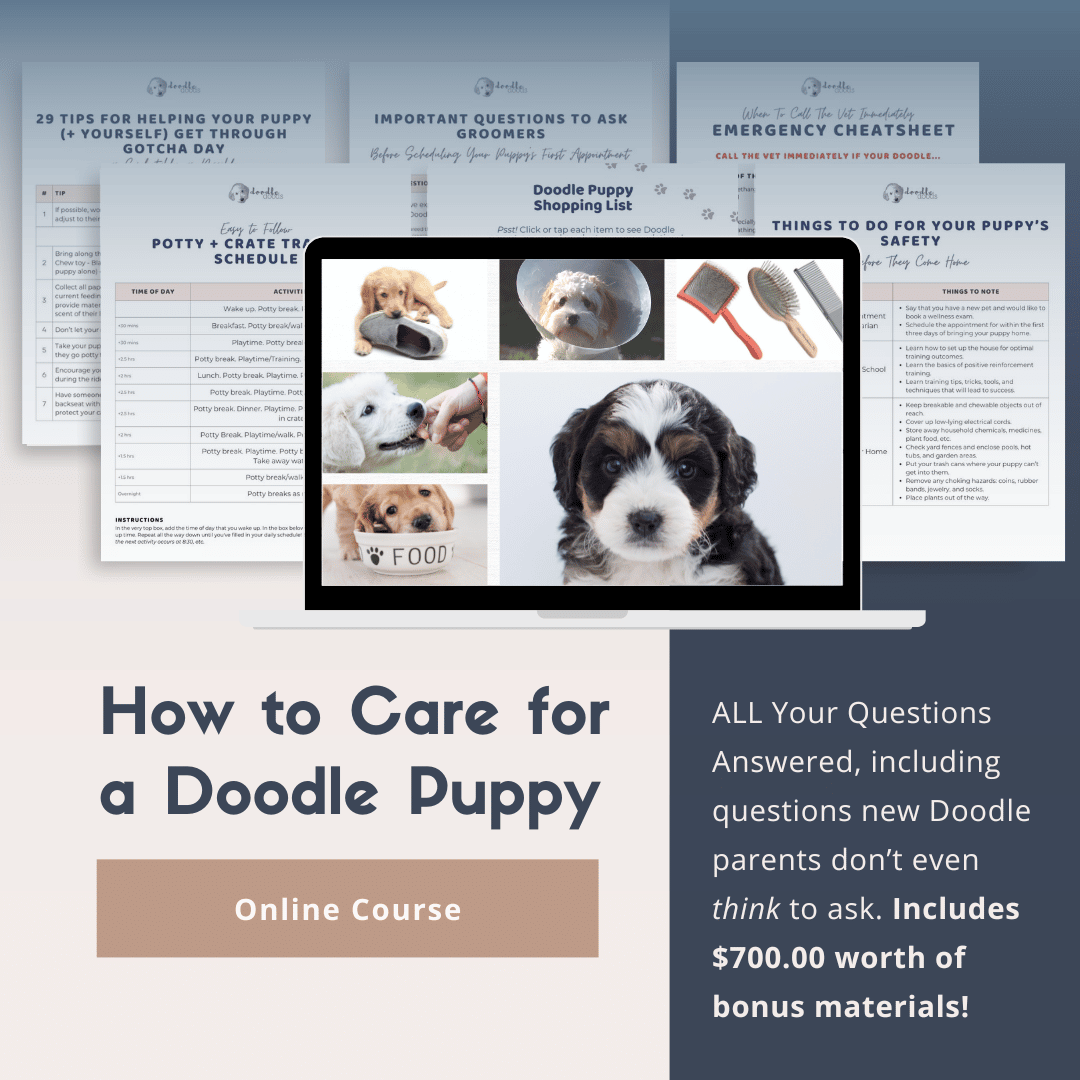
Perfect for first-time Doodle parents, get ALL your questions answered, including questions new Doodle parents don’t even think to ask.
Plus, get $700 worth of Bonus Materials for FREE, including:- Doodle Parenthood Community and Support Group ($190 value)
- Doodle Puppy Growth Tracker ($20 value)
- EMERGENCY Cheatsheet: When To Call The Vet Immediately ($50 value)
- HELP! Button ($145 value)
- And SO MUCH MORE!
The information on this page is for informational purposes only. It is not intended to be a substitute for qualified professional veterinary advice, diagnosis, or treatment. Always seek the advice of your veterinarian or other qualified animal health provider with any questions you may have.


